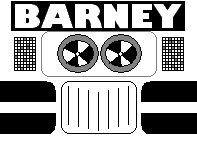HOW TO BUILD A JUDGE DREDD COSTUME
BY KEVIN GOLDSMITH
THE HELMET
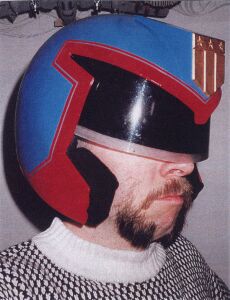 |
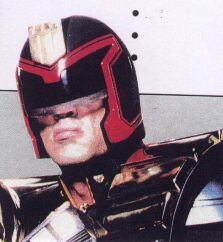 |
Some years ago, I had come across an old, full-face, motorcycle crash helmet in a skip. This was just after the Sylvester Stallone movie had been released. I had the thought of one day turning it into Britain's top comic book hero's main symbol, so I retrieved it and placed it in a cupboard at home. Towards the end of summer '98 I received a letter from Ian Marchant - who had lost his Mum to cancer about a week before I lost mine. Part of the letter stated that he had made a 1:1 Judge Dredd helmet out of an old open-faced motorcycle helmet. "This I gotta see!" I said, though he did not specify whether it was the comic version or movie, and I forgot to ask!
The following weekend he came over to my house for a chinwag. He produced the helmet from a bag - I nearly had kittens! It was mega! (excuse the pun!) He described how he made it, and low and behold it was practically the same way that I had made the miniature one for my Action Man scratchbuild - see introduction. I took several photos for reference.
A few weeks later I visited his house, and interviewed him again about the helmet - this time taping the conversation. Ian allowed me to wear the helmet, and I realised how little you could see out of the smoked visor. If you think of the comic visor design, it makes you realise that our top lawman must have been one hell of a shot!!!! I have since seen a photo that Ian took of me in his helmet - I look about 84?!!!!
Ian told me that he has shown the helmet at a number of conventions, with some good reactions. I'm not surprised! He also told me that it only took him a few days to make - it took about a month for mine!
The helmet is one of the more modem types, with the visor fitting flush with the side and front of it. There are air vents on the cheek areas for letting air flow in and out, this presumably preventing the visor from misting over. These indentations would allow me to convert the helmet in a different way; this is not to insult Ian - far from it. It is just that different modelmakers do things in different ways. The indentations on the sides of the helmet, where the sockets are that allow the visor to pivot up and down, and the area on top of the helmet where the gold emblem goes (referred to in the comic as the respirator) were the only areas that I could insert wire through to eventually hold the Dredd visor and internal padding firmly in place. All other areas of the helmet would of course be exposed.
I began by firstly removing the visor and internal padding. Some of the foam packing on the inside of the black cloth that covered the head padding had gone rotten, so I discarded it. I then with a small hacksaw sawed off part of the front jaw section. Part of this I kept for running tests on the glue (I used Superglue throughout), and paint, to ensure that neither attacked the plastic or each other.
I then referred to my 'The Making Of Judge Dredd' book again. I used the photo showing a close up side-ish view of the helmet, to draw black lines down both sides of it. Once I was satisfied that the lines were as accurate as I could get them, I first of all hacksawed as close to the lines as I dared, and then carved, filed and finally sanded the edges round and smooth.
I then got to work on the main inner padding, which was shaped not unlike a modern-day cyclist's helmet, eased it back into the main shell, and marked out where it protruded out from the brow. Removing it from the main shell, I proceeded to cut away the polystyrene from the brow. I did not bother with the 'V' shaped side areas, as these were out of my eyeline, but I did this:

Once I was satisfied with this, I started on what turned out to be the hardest, but most important: the visor. I had some clear plastic in the house, but this shattered when I tried to bend it, even when warmed up, so I searched around Bicester for some-hah!
We have two model shops. One didn't do sheet plastic and the other hadn't had any in for at least three month's (!) and the local hardware store could do nothing smaller than 3 feet by 6 feet - a bit on the big side!!
So a trip to London was called for - I was going to go anyway. Beatties sorted me out with 4 sheets of 1mm thick A4 size. I thought that I was over doing it with four sheets, but as it turned out I only just had enough! After a lot of fiddling around, I arrived at this shape:

Then came the 'smoked' effect. Ian said that he used a spray-on stuff that you use to dull down the insides of car headlights. The nearest that I found was Hycote-Window Tint(smoke), that you use to darken car windows, presumably the same sort of stuff. I did the white-ish line that runs 1m across the bottom of the visor by masking off a half-inch strip. The trouble was, some of the spray had leaked through parts of the masking tape, leaving a mess, so I scraped off the worst of this and carefully sanded along the strip with rough sandpaper. When seen from the outside, this gave the desired effect. I laid the visor as
flat as I could - be warned, this stuff runs faster than the after effects of a bad curry! I sprayed on a couple of coats, letting each one totally dry each time. The trouble was, most of it had pooled in the middle, so I had to ditch the whole thing and start again. Once I had rebuilt it, I bent the visor so that when laid down the inside middle was slightly upwards, so that any pooling would be at each end - out of the range of my eyesight - this worked. I ended up spraying on about four coats. With this amount on, it was dark enough to look right, but light enough to see through. The white areas on the ends were covered with gloss black.
I then drilled three holes
in the visor. ![]()
Before going any further -
or before I forgot!, I made the small 'knob' that extends from
the helmet's middlebrow. In the comic this comes down, and ends
up in an inverted 'Y' shape around the nose. I cut a piece this
shape: ![]() from 2mm thick styrene sheet and glued it in place.
This was filed where necessary and the outer edges sanded round
to match the rest of the helmet rim.
from 2mm thick styrene sheet and glued it in place.
This was filed where necessary and the outer edges sanded round
to match the rest of the helmet rim.
I then decided to test fit
the three main items: the visor and the polystyrene padding to
the main shell. I first drilled five holes in the helmet, one in
the top where the respirator would eventually go , and two in the middle of the two
side indentations, but about a l/4 inch apart and 3/4 inch from
the rim. I then cut three 4 inch lengths of wire, bent 2 into a
'U' shape for the sides, and after a bit of fiddling had the
visor in place with the wire. After coaxing the padding into
place - I found at this point that I had to carve a trench 2
inches wide by 5 inches long and a l/4 inch deep across the top
front of the padding, to make more room for the visor. Once this
was done, I placed the helmet assembly on my head. I found that I
had to drill another hole about 7mm above the two side ones -
making the visor jut out a bit more at the bottom rim. I tried
the helmet on again, and the rim almost came to the bottom of my
nose -which was about right. It was also taking shape - when I
looked in a mirror I could see Dredd - all be it a semi-goatee
bearded version!!!
, and two in the middle of the two
side indentations, but about a l/4 inch apart and 3/4 inch from
the rim. I then cut three 4 inch lengths of wire, bent 2 into a
'U' shape for the sides, and after a bit of fiddling had the
visor in place with the wire. After coaxing the padding into
place - I found at this point that I had to carve a trench 2
inches wide by 5 inches long and a l/4 inch deep across the top
front of the padding, to make more room for the visor. Once this
was done, I placed the helmet assembly on my head. I found that I
had to drill another hole about 7mm above the two side ones -
making the visor jut out a bit more at the bottom rim. I tried
the helmet on again, and the rim almost came to the bottom of my
nose -which was about right. It was also taking shape - when I
looked in a mirror I could see Dredd - all be it a semi-goatee
bearded version!!!
I removed the visor and padding before going on. I glued bits of styrene to the inside walls of the side indentations to cover the two large holes that allowed the helmet's original visor to pivot up and down. I then painted the inside area of the shell where the visor would be gloss red 19 - as this would be impossible to get at when the visor was permanently in place. Two coats sorted this out.
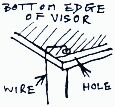 I then cut 3 more new lengths of
green garden wire, and put the visor back in -this time
permanently. The wire through the top of the helmet was done the
same as the 'test fit'. The sides were done the same as well,
except that the 2 ends of the wire were twisted tight, and then
laid flat at right angles against the outer surface of the
indentations. This also pulled the visor closer to the rim of the
helmet in these areas - just like in the film.
I then cut 3 more new lengths of
green garden wire, and put the visor back in -this time
permanently. The wire through the top of the helmet was done the
same as the 'test fit'. The sides were done the same as well,
except that the 2 ends of the wire were twisted tight, and then
laid flat at right angles against the outer surface of the
indentations. This also pulled the visor closer to the rim of the
helmet in these areas - just like in the film.
Then came the cheek padding. In the comic there is a gap of about 1-inch. Believe me, that if Dredd turned his head too quickly, the helmet would stay put! In the film the helmet fits very close to the head, so I had to compromise - keep the padding thick so that it would make the helmet fit snugly on my head.
I cut away and discarded the mid section of the padding, and once again had to get rid of the black cloth as the inner foam lining had gone rotten. This was replaced with black material from an old T-shirt - no not one of yours Andrew!
I glued the cloth to the foam with Evo-Stick. I could have used Superglue, but this would have made the cloth rock hard and brittle. Again I ran a test on that jaw piece of the helmet that I mentioned earlier. It stuck to the plastic with no problems. I allowed a full day for the glue on the foam and cloth to dry before gluing the pads into the helmet. Both were held in place with a 'G' clamp each. Again I allowed a full day's drying time.
I then tackled an area that Ian did not - the black padding around the base of the neck. Again, I studied the close up of Dredd's head. The padding is in three pieces, two short side pieces starting just behind the cheek guards and one long one around the back.
The bottom rim curved around
enough for me to drill a series of small holes -immediately
behind the cheek guards, spread about 1/4 inch apart. I had a
look through a cupboard and found some pieces of 2mm thick
leather and cut pieces this shape:
I then sewed these together to form 3 pieces, and then sewed them to the helmet, the two small bits first, then the big piece.
Then the respirator. I took
a piece of card and cut it to fit the contour of the helmet,
after which I studied several photos of the helmet to judge
(sorry!) the upper and front section. To save you a bit of time,
I have drawn the template here: 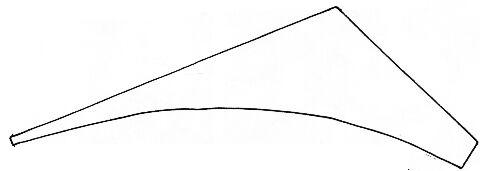
I then sanded the entire
outside surface of the helmet to rough it up a little -this would
eventually give the paint something to stick to. After this I
sketched a rough outline of the respirator on the helmet, by
drawing 2 lines each side of the faint mould line that runs from
the brow to the bottom of the neck - these lines should each be 1
inch away from the mouldline. 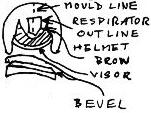 I then drew 3 others like this:
I then drew 3 others like this:
Using the template as a guide, I cut out 2 plastic pieces and glued them either side of the mould line, and then made 2 further pieces about this shape:
and glued these to the front
of the other two. I then took several little pieces of styrene
and glued them to the helmet surface to give the side pieces more
strength. After this I made 2 ![]() shaped pieces to fit on
the front, and make it jut out the necessary amount. After
cutting and fitting the top piece, I filed and sanded where
necessary. To make the gold emblem, I cut a further
shaped pieces to fit on
the front, and make it jut out the necessary amount. After
cutting and fitting the top piece, I filed and sanded where
necessary. To make the gold emblem, I cut a further ![]() shaped
piece, cut it into 4 strips thus:
shaped
piece, cut it into 4 strips thus: ![]() and bevelling all edges,
the 3 stars on the top piece were done by firstly drawing on a
star shape
and bevelling all edges,
the 3 stars on the top piece were done by firstly drawing on a
star shape  and then cutting each segment at 4 different angles.
and then cutting each segment at 4 different angles. ![]() I
then glued all pieces into place.
I
then glued all pieces into place.
Lastly, to fill in all the aforementioned indentations, I firstly glued in little bits of styrene for the main filling, then did the rest with about 3 layers of model filler. I was going to use some car body filler, but the stuff that I already had was years old. I ran a test. It is nearly a month since I finished the helmet and the bloody stuff still has not gone hard! I sanded the model filler to a smooth-ish texture.
Then it came to the painting. For the main colour I ignored any scenes from the movie itself - even daylight ones. As best as I could I remembered a photo of the helmet taken in the studio where it was built, and ended up with Holts Austin Rover Pageant Blue car paint.
I carefully masked off the visor with 2 layers of paper, and did the same for the cheek padding and inside. I sprayed on about three layers to give a good overall coverage, and then left it to dry for 6 days (that's what it said on the can, and I was not taking chances!).
As for the red stripes, I found an old Archers circuit echant kit, which had two rolls of thick masking tape. These proved ideal. One was 2mm wide, the other 3mm. The 2mm was used to produce the middle gap, the other the inner edge. I painted on 2 coats of gloss 19 red, and once the tape was peeled off, I
only had to do a bit of touching up to what was a great finish. Spraying on to a piece of card and dabbing the brush in the 'puddle' did the blue. When I had finished, the brush was cleaned with cellulose thinners. Lastly, the neck padding was blackened with a bottle of leather dye - mine came with a brush of sorts, though you could always use a marker pen.
The helmet was finished!
I am certainly extremely pleased with the results, and whilst not absolutely perfect, it cannot be mistaken for anything else - which is what counts.
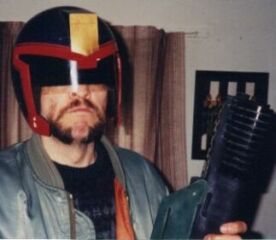 |
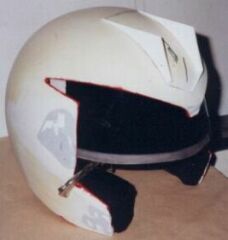 |
At left, Dredd at 84...actually me in Ian's helmet. At right, my helmet 3/4 complete, white bits of visor can be seen just left of middle. Below this, bits of plastic and filler used to fill in side and cheek guard indentations. Top right, respirator side pieces, wire holding head padding and visor in place can also be seen.
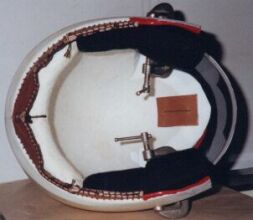 |
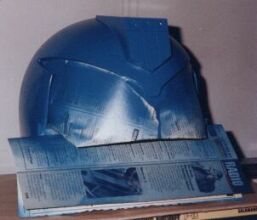 |
At left, inside of helmet can be seen. Just right of centre, piece of leather to prevent wire from damaging polystyrene head padding. 'G' clamps, top and bottom, hold cheek padding in place whilst glue dries. Stitching can also be seen to hold neck padding in place on left of picture. At right, helmet masked off with blue paint applied, horizontal piece of paper at bottom is to make sure no paint got inside the helmet.
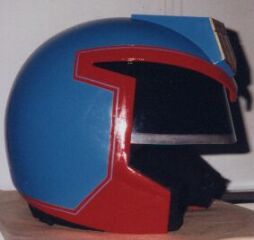 |
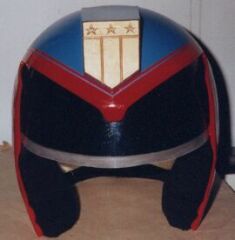 |
My finished helmet
![]() Judge Dredd and 2000 AD © Rebellion A/S 2008.
Judge Dredd and 2000 AD © Rebellion A/S 2008.
BARNEY is a fan site by
based on 2000 AD Online 2001-2008.
